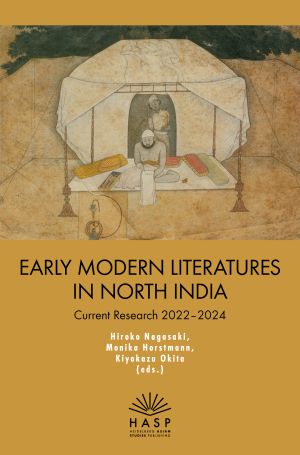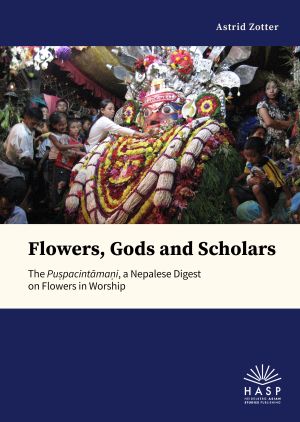Bücher

Sūryās Hochzeit
Der Ṛgveda ist eine gegen 1000 v. Chr. angelegte Sammlung von gut tausend Sanskrit-Hymnen, die typischerweise einen hochpoetischen Stil aufweisen. Das in dieser Sammlung überlieferte Sūryāsūkta (Ṛgveda 10.85) gilt jedoch als lose strukturierte Zusammenstellung hochzeitsbezogener Strophen.
Im vorliegenden Buch stellt Anne Keßler-Persaud diese grundlegende Annahme zum Textualitätsgrad des Sūryāsūkta in Frage. Mithilfe textlinguistischer und hermeneutischer Verfahren belegt sie eine hohe Kohärenz dieses Textes. Das Sūryāsūkta zeigt eine ausgefeilte metrische und rhetorische Struktur, und kommuniziert auf poetische Weise einen gleichfalls kohärenten Ablauf des Hochzeitsrituals der Göttin Sūryā.

Early Modern Literatures in North India
The volume represents the Proceedings of the 14th International Conference on Early Modern Literatures of North India, Osaka University, 15—19 July 2022.It spans textual studies and criticism, bhakti religious traditions, the transcreation of classical texts in the vernaculars, and multilinguality. It also addresses the history of the conference series and of the collection of manuscript resources in the 1970s which hence have formed a major base of studies in the Sant tradition.

Crafting Potency
Crafting Potency investigates the intricate meshwork of theories and practices of potency in Sowa Rigpa (Tibetan medicine). Informed by Tibetan medical literature and extensive fieldwork with practitioners (amchis) from Ladakh, Dharamsala, and Kathmandu, the authors explore how the potency of substances is understood, sculpted, and refined in the making of multi-ingredient medicines. Utilizing Tim Ingold’s concepts of “skilled practice” and “meshworks” alongside Pamela Smith’s “artisanal epistemologies,” potency is presented as a potential that is crafted and realized through practice. The book explores the impacts on knowledge transmission of both institutional training and traditional lineage-based medicine making. It highlights the deep immersion of amchis in their social, ecological, technical, and spiritual environments, contributing nuanced practice-based perspectives to the anthropology of materials and the history of science.

Here and Elsewhere
Here and Elsewhere offers a grounded study of crucial modes of sanctification and imagination of Hindu geographies: spatial transposition and substitute pilgrimage. It looks at the local representatives of the pan-Indian jyotirliṅgas in Varanasi (Banaras) and the urban pilgrimage connected to them by combining interpretative analysis of glorifications (māhātmyas) with in-depth ethnographic research. This enables the author closely to observe the strategies that a variety of social actors employ to knit together and reproduce connections between places of the here and the elsewhere, and to locate deities and themselves within multiple spatial dimensions, both lived and imagined.

Routes, Patterns, Ideologies
Hindu sacred geographies are shaped by interwoven webs of myth, ritual, and pilgrimage. Routes, Patterns, Ideologies: Navigating Sacred Sites in India brings together essays that offer in-depth explorations of Hindu sacred spaces, focusing on the relationships between sites as a crucial dimension of their theological and social significance. Drawing on textual analysis, visual studies, and ethnographic insights, the contributors to this volume illuminate the patterns and mechanisms that link sacred sites into dynamic networks, demonstrating how sacrality is continually negotiated through evolving cultural, political, and theological landscapes.

Flowers, Gods and Scholars
Der Puṣpacintāmaṇi ist ein nepalisches Kompendium (nibandha) aus dem 17. Jh., das autoritative Zitate zur Verwendung von Blüten in der hinduistischen Verehrung (pūjā) vereint. Dieses Buch enthält eine kritische Edition und Übersetzung des Sanskrittextes und seiner Wiedergabe in Newari, sowie botanische Identifikationen der erwähnten Blüten. Darüber hinaus analysiert es den historischen und kulturellen Kontext des Textes, u.a. seine Rolle in der Texttradition Nepals und seine Beziehungen zu anderen Vertretern seines Genres.
Es handelt sich um eine englische Version der Dissertationsschrift “Von Blüten, Göttern und Gelehrten: Die Behandlung von pūjā-Blüten im Puṣpacintāmaṇi” (http://nbn-resolving.de/urn:nbn:de:bsz:15-qucosa-102174).

Reframing Tradition
The volume presents recent scholarly research on texts and performative traditions of India in the early modern and colonial periods with a specific focus on challenges to conventional norms in literary, social, and political contexts. It gathers a selection of contributions, presented at the international webinar on “Transmission, Alteration, and Voices: Texts and
Performative Traditions in South Asia in the Early Modern and Colonial Periods”, which bring new material to approach the variety of intentions involved in transmitting and altering texts and ideas. Arranged in four parts - Adaptation and Translation, Between Performance and Script, Genres and Kingdoms, and Voices and Gender - the essays investigate altering concepts from different angles and traditions (Hindu, Muslim, Jain, Sikh). The authors shed light on exchanges pertaining to sectarian, cultural, and political issues and examine redirections by questioning channels of transmission and media used to convey transformational concepts. The topics covered include retellings in vernaculars and their adaptations to new socio-cultural contexts, transitions from oral to written traditions and contemporary performance, alterations of genres and styles in their association with courtly milieus and historical background, questions of gender and voices raised to stimulate social and political change. Strategies for creating and transforming spaces for communication of new clusters, genres, sectarian systems, and artistic representations are also discussed. The volume thus displays multiple ways of reframing tradition and diverting the course of established concepts as a common feature found across the landscapes of South Asia during these periods.

Among Tibetan Materialities
Among Tibetan Materialities greift durch eine kritische Auseinandersetzung mit materieller Kultur in die klassischen Tibetstudien ein. Das Buch eröffnet neue Quellen, Methoden und Rahmenbedingungen für das Studium, Nachdenken und Schreiben über materielle Kultur, Materialien und Materialität in Tibet und im Himalaya. Es zeigt neue Möglichkeiten auf, wie diese Regionen über ihren lokalen Kontext hinaus relevant gemacht werden können. Die vorliegende Sammlung laufender Forschungsarbeiten zu historischen und Gegenwartsthemen durchbricht aktuelle Ansätze zur tibetischen und Himalaya-Materialität, indem sozial konstruierte Materialität und Materialien, aus denen Dinge bestehen, von ihrer Konzeption und Produktion bis zu ihrem Lebensende und darüber hinaus betrachtet werden.







